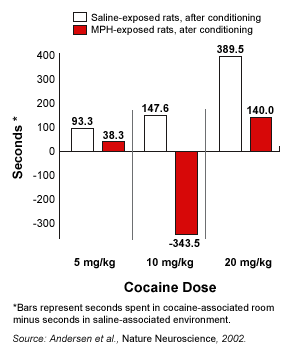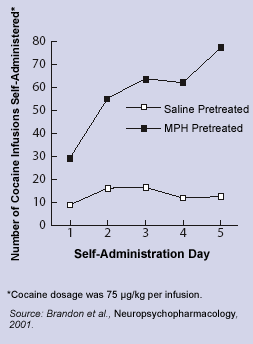 |

By Jill Schlabig Williams, NIDA NOTES Contributing Writer, and
Patrick Zickler, NIDA NOTES Staff Writer
More than 2 million American children--an estimated 5 to 10 percent of preteens--have been diagnosed with attention-deficit/hyperactivity disorder (ADHD). For many of these children, treatment with psychostimulant medications such as Ritalin (methylphenidate, or MPH) suppresses the impulsivity, fidgeting, and inability to concentrate that characterize the disorder. Appropriate use of psychostimulants in children with ADHD also has been shown to reduce the likelihood that these children will develop drug or alcohol use disorders when they reach adolescence and adulthood (see "Studies Link Stimulant Treatment of ADHD in Childhood to Lower Risk of Later Substance Abuse").
While the benefits of psychostimulant treatment for ADHD are clear, scientists are only beginning to explore how these medications help protect children with ADHD against later drug abuse. Two possible explanations have been proposed--one neurobiological and the other psychosocial. Stimulant medications might make drugs less desirable through direct neurobiological effects in the brain that reduce the pleasurable effect that drugs elicit. A second explanation is that the medications may reduce children's vulnerability by helping them act less impulsively, perform better in school, and relate better to others, thereby reducing negative feelings and the likelihood of joining socially deviant peer groups--psychosocial characteristics known to be risks for drug-taking. Possibly, both mechanisms contribute to reduced risk.
Two recent NIDA-supported studies have begun to investigate the neurobiological effect of stimulant medications by studying rats exposed to MPH. Researchers at the McLean Hospital in Belmont, Massachusetts, and the Chicago Medical School exposed rats to MPH during periods when the animal brain is in developmental stages that correspond to human childhood and adolescence.
Scientists stipulate that while responses observed in laboratory animals are suggestive, they do not necessarily indicate that humans will be affected in the same way. Moreover, because researchers have yet to identify the specific brain features that give rise to ADHD, it is even less possible to say whether the current results with MPH have relevance for young people who receive MPH for that disorder. With those caveats, however, the results of these preliminary studies suggest that MPH does have a neurobiological effect that lasts into adulthood.
Exposure During Childhood
|
 Before place conditioning, rats spent equal time in the saline- and cocaine-associated rooms. After place conditioning, rats exposed to saline in childhood showed a dose-related preference for the cocaine-associated room. However, MPH-exposed rats actively avoided the room they had been conditioned to associate with cocaine at a 10 mg/kg dose. Although these rats spent slightly more time in the room they associated with cocaine at a 20 mg/kg dose, this difference did not reach the level of statistical significance and thus did not show that they were attracted to this room more than the saline-associated room. |
|
At McLean Hospital, Dr. Susan Andersen and her colleagues injected groups of eight male rats with either MPH (2 mg/kg) or saline twice daily. The animals were exposed to the medication during a period when the rat brain is in a developmental stage equivalent to human childhood--on days 20 through 35 following birth. At adulthood (day 60), the rats were tested with a method called place conditioning, in which they learn to associate drug effects with a particular environment. On two consecutive days, the rats received two conditioning trials in which both saline-exposed and MPH-exposed rats were given saline and confined for 1 hour to a side room of a three-room cage before being returned to the central room. Three hours later, the rats received cocaine in a 5, 10, or 20 mg/kg dose and were confined to the other side room for 1 hour before being returned to the central room. On the third day of the study, the rats were allowed to freely explore the entire cage for 30 minutes, while researchers measured the time they spent in the room associated with saline and in the room associated with cocaine.
Adult rats that initially received placebo in childhood showed a dose-related preference for the room associated with cocaine. The higher the dose of cocaine they received, the more time they spent in the room they had learned to associate with cocaine. However, the MPH-exposed rats did not follow this pattern. After receiving either moderate or high cocaine doses, they did not establish place preference for the cocaine-associated room. MPH-exposed rats that received a moderate cocaine dose tended to avoid the cocaine-associated room, spending less time there than in the saline-associated room. MPH rats that received a high dose of cocaine spent slightly more time in the cocaine-associated room, but only about one-third as much time as the unexposed rats. "Their response was definitely blunted," Dr. Andersen says.
The findings reported by Dr. Andersen's research group suggest that, in rats, MPH exposure has a neurobiological effect that is protective later in life. "Rats exposed to MPH during the period equivalent to human childhood experience behavioral changes that endure into adulthood and are more sensitive to cocaine's unpleasant effects," Dr. Andersen observes.
Despite these findings, Dr. Andersen cautions, it is still too early to make assumptions about any neurobiological effect of MPH on vulnerability to cocaine abuse.
"There is still a great deal of research to be done in this area. We need to investigate the role of dose, gender, age of exposure, and treatment duration and to examine how MPH affects other reward systems, such as responses to sex or food," concludes Dr. Andersen.
Exposure During Adolescence
|
 Adult rats exposed to MPH during the period corresponding to human adolescence self-administered significantly more cocaine than did rats exposed to placebo in adolescence. Rats self-administered 75 μg/kg of cocaine by poking their noses into a hole in their treatment chamber. This action switched on an infusion pump for 3 seconds, delivering cocaine via a jugular catheter. |
|
At the Chicago Medical School, Dr. Cindy Brandon, Dr. Frank White, and colleagues exposed male rats to daily doses of MPH (2 mg/kg) or saline from days 35 to 42 after birth, when the rats are going through a period of brain development corresponding to human adolescence. When the rats reached adulthood
(56 days of age), they were put into boxes with two holes into which
they could poke their noses. Poking through one hole triggered an infusion of cocaine (75 μg/kg). Poking through the other hole triggered an infusion of saline solution. The scientists recorded the number of pokes in both holes over 5 days.
Rats that had not been exposed to MPH during adolescence triggered few infusions, and the rate did not increase over the course of the experiment. Rats that had been exposed to MPH in adolescence, however, began self-administering cocaine on the first day and triggered increasingly more infusions on each successive day. By day 5, they were self-administering cocaine at a rate more than seven times that of the rats not exposed to MPH. "Adult animals exposed to
MPH during adolescence were considerably more vulnerable to the
reinforcing effects of cocaine," Dr. White explains. "From these results, it is reasonable to suspect that in humans, adolescent exposure to MPH may increase future vulnerability to low doses of cocaine."
Implications for Future Research
This study, like the work done by Dr. Andersen's group, suggests that exposure to MPH has a neurobiological effect that persists into adult life. However, in this study, the effect is to increase risk rather than to confer protection. "It's important to keep in mind that my study and Dr. Andersen's study measured two different behaviors. Place preference studies can be seen as a model of the animals 'wanting' the drug, while self-administration studies involve actually taking the drug. These methods are not measuring the same processes in the brain," Dr. Brandon says.
"What these animal studies suggest is that, on a neurobiological level, early exposure to MPH has effects that persist into later life," says Dr. Susan Volman of NIDA's Division of Neuroscience and Behavioral Research. "They also indicate that the timing of exposure--whether the animals are exposed during childhood or adolescence--plays a role in later behavior in the animals."
Only continued investigation will clarify the extent to which the neurobiological results seen in rats, which do not have ADHD, might also be relevant to humans with or without ADHD. "There's still a great deal we need to learn about exposing a developing brain to MPH," Dr. Volman says. "We just don't know enough yet about the enduring changes that may result."
Sources
Andersen, S.L., et al. Altered responsiveness to cocaine in rats exposed to methylphenidate during development. Nature Neuroscience (5)1:13-14, 2002.
Brandon, C.L.; Marinelli, M.; Baker, L.; and White, F.J. Enhanced reactivity and vulnerability to cocaine following methylphenidate treatment in adolescent rats. Neuropsychopharmacology 25(5):651-661, 2001.
Studies Link Stimulant Treatment of ADHD in Childhood to Lower
Risk of Later Substance Abuse
Children treated for attention-deficit/hyperactivity disorder (ADHD) with stimulant medications are less likely to develop substance abuse disorders later in life than are children with ADHD who are not given stimulants, according to NIDA-supported researchers. Dr. Timothy Wilens and his colleagues at the Massachusetts General Hospital and Harvard Medical School in Boston reviewed long-term studies in which stimulant-treated and untreated children with ADHD were evaluated later in life and concluded that stimulant therapy cuts in half the likelihood of subsequent substance abuse disorders.
The researchers examined six studies with a combined total of 647 children with ADHD who had been treated with stimulants and 360 who had not. On average, the studies followed up on the participants for 6 years (range 4 to 15 years) after treatment ended and they were more than 20 years old (range 15 to 22 years of age). Four of the six studies included treated and untreated participants with similar severity in their initial diagnoses. The studies found less incidence of any substance abuse disorder in participants treated with stimulants. One study in which the severity of initial diagnosis was not similar for treated and untreated groups found that participants who received stimulants were more likely to smoke and to abuse cocaine, but not more likely to abuse alcohol or marijuana. The other study in which diagnostic severity was not matched found that stimulant-treated participants were more likely to abuse alcohol or marijuana.
"Considering all six studies, there was an almost twofold decrease in the likelihood of substance abuse disorders risk for youths treated previously with stimulant medication," Dr. Wilens says.
The Harvard group's findings counter concerns voiced by some practitioners that exposure to stimulants might increase children's disposition to subsequently abuse drugs. "These findings should reassure clinicians and families by providing compelling evidence that pharmacotherapy with stimulants for ADHD does not lead to substance abuse disorders, but instead seems to have protective effects," says Dr. Wilens.
Source
Wilens, T.E., et al. Does stimulant therapy of attention-deficit/hyperactivity disorder beget later substance abuse?
A meta-analytic review of the literature. Pediatrics 111(1):179-185, 2003.
|
Volume 18, Number 1 (June 2003)
|
 |
|